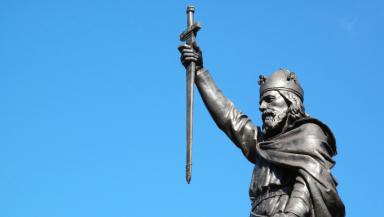
26 October is the day when many churches remember the Christian King Alfred the Great. He was driven by biblical principles and was the only English king to translate parts of the Bible into English. This is the story …
Birth
Alfred was born in Wantage in the Vale of the White Horse near Oxford in England in or about AD 849. He was born into the Saxon royal family of the House of Wessex. His parents were King Ethelwulf who reigned from AD 835 to 898, and his wife Osburh. It was never imagined that Alfred would be king because he was the youngest of five brothers. Christian Beliefs
Alfred was brought up in the Christian faith. As boys the brothers Ethelred and Alfred were taken to Rome and met Leo IV. This was later retold in the Anglo-Saxon Chronicle implying that the Pope anointed Alfred as a future king, in a story to liken Alfred to King David, the youngest of Jesse’s sons, who was anointed by Samuel, and later became king (1 Samuel 16:4-23).
Succession
King Ethelwulf died in AD 869. One by one Alfred’s brothers became king and then died and were succeeded by the next one. King Ethelbald reigned for two years and died in AD 860, then his brother Ethelbert reigned for five years and died in AD 865, and then Ethelred I reigned for six years and died in AD 871. When Ethelred died his two sons were too young and the Witan (Saxon Parliament) offered the throne to his brother Alfred.
By 871, when Alfred had become king, he had a strong faith, and a knowledge of the Bible. Prayer, Christian counsel, and biblical principles were behind many of the things which he did.
Peace
King Alfred’s reign was beset by attacks from the Danes and the Vikings who had already conquered Northumbria and East Anglia. The large force of Vikings was known as the “Great Heathen Army”. Under King Alfred, the English won a great naval battle in the bay of Swanage in Dorset in AD 877, followed by a great land victory at the Battle of Edington in Wiltshire in AD 878.
Baptism of Guthrum
In AD 878 the Danish leader Guthrum was defeated, but Alfred decided to make an honourable and merciful agreement with him and love his enemies (Matthew 5:43-48). Thirty leading Danish chiefs, including Guthrum, came forward to convert to Christianity, and were baptised at Aller, near Athelney in Somerset, and the font is still in the parish church.
King Alfred was godfather to Guthrum at his baptism, and Guthrum took the new name of Athelstan and was allowed to rule East Anglia. A treaty between them led to peace which treated English and Danes as equals (based on Leviticus 19:35). Guthrum ruled as a Christian king, which was a step towards the conversion of the Danes and Vikings in Britain.
Military
To protect Wessex from further attacks he created a network of fortified towns called burghs and created a militia. Today towns in southern England with the suffix “bury” like Aylesbury and Banbury are witness to their origin as a fortified burgh settlement from Alfred’s time.
The Church
With peace in place Alfred was able to work at reviving the English Church. He founded monasteries at Athelney and Shaftesbury and appointed pious and learned bishops and abbots. Alfred’s work led landowners to provide small chapels on their land where local people could attend, and many of these in later centuries were enlarged to become parish churches.
Learning
Alfred recruited great scholars from around Britain, Gaul and Saxony in Europe to help revive Christian learning. Notably he recruited a Welsh monk from St David’s in Wales, who was called Asser, or known as Asserius Menevensis in Latin. Asser was later made Bishop of Sherborne from 892.
Translation
King Alfred learnt Latin and personally translated some works from Latin into the language of the Anglo-Saxons. The Anglo-Saxon language is effectively early English, often called Old English, except it is so different to modern English that people now learn it like a foreign language. Alfred wanted key texts available in English, rather than just Latin. Of the works attributed to him we can’t be sure if he translated them all himself, or whether he commissioned the translation.
He translated the Venerable Bede’s “Historia ecclesiastica gentis Anglorum” (Ecclesiastical History of the people of England) from Latin into Anglo-Saxon. He then commissioned the Anglo-Saxon Chronicle, which was a written history of the English people to take the story from where Bede left off. Different monasteries continued to update it, with the Peterborough version continually updated into Norman times, up to 1154.
He translated the “Regula Pastoralis” (Pastoral Care) by Pope Gregory the Great, known as the Apostle to the English, which was a manual for bishops and clergy. Alfred added to this a preface which explained his educational reforms, and a copy was given to every bishop. In this preface Alfred lamented the decline of learning in England and declared that certain books were “the most needful for all men to know”. He proposed that children learn to read English, and then Latin only if they needed them for holy orders.
He translated the “Soliloquies” by St Augustine of Hippo, which is a devotional dialogue on the search for God and the nature of the soul. He translated - or commissioned to be translated - “Historia adversus paganos” (literally “History against the Pagans”) which was an account written about Christian providence through history.
Psalms
However King Alfred is most famous for translating psalms. William of Malmesbury, writing in about 1125, recorded that King Alfred had finished translating the first fifty psalms shortly before his death. These psalms quite likely appealed to Alfred because of their portrayal of King David’s struggles against his enemies, which were echoed by Alfred’s own struggles.
The translation survives in a manuscript known as the Paris Psalter because it is housed in the Bibliothèque Nationale de France. This contains the 150 Latin Psalms with facing Anglo-Saxon translations. The first fifty psalms are in prose attributed to Alfred, and the remaining hundred are by a later translator. These are now transcribed and can be read online or in the YouVersion app under ‘Anglo-Saxon’.
Law
King Alfred was known for his wise laws based upon previous codes and his understanding of biblical law. His law code includes many translations of passages of Scripture. He begins with a prologue that includes translations into Anglo-Saxon of the Ten Commandments from Exodus 20:1-17. He quotes Old Testament case laws to establish common law.
Alfred’s prologue also incorporated the Sermon on the Mount in Matthew chapter 5, the Golden Rule (Matthew 7:12) and passages from about the ‘Council of Jerusalem’ (Acts 15), which abrogated the Gentile Christians from the obligations of the Mosaic Law.
Alfred drew upon biblical principles, from the Old and New Testaments, to create just and fair laws, which were widely respected.
Death
King Alfred the Great died on 26 October, AD 899. After his death he was succeeded by his son Edward who became known as Edward the Elder, to distinguish him from Edward the Martyr and Edward the Confessor.
Alfred was buried in the old Minster at Winchester. Around AD 904 his family’s remains were moved to the New Minister and then in AD 1110 they were moved to Hyde Abbey in Winchester. In 1539, Hyde Abbey, which was already in ruins, was lost during the Dissolution of the monasteries. Some of his remains were possibly found in 2013.
Sources
We know quite a lot about King Alfred from the Anglo-Saxon Chronicles and “Vita Ælfredi regis Angul Saxonum” (The Life of King Alfred king of the Anglo-Saxons), written by the Welsh bishop Asser. Alfred the Great is also mentioned in some surviving charters.
Reputation
King Alfred was never called “the Great” during his lifetime. He was given the epithet of “the Great” in the 13th century and it stuck. The earliest recorded reference is in a book by the English Benedictine monk Matthew Paris who was based at St Albans. Matthew Paris wrote "Historia Anglorum" (History of the English) which has a marginal annotation to “Rex Alfredus magnus” (King Alfred the Great). In the Tudor period Matthew Parker and John Foxe both helped to popularise King Alfred as a foundational English figure in the history of the Church, because of his role in leading the Church and promoting the use of English over Latin.
Monuments
Today Alfred the Great is commemorated with monuments and statues, which have been put up at places connected to his life. There is a tower called King Alfred’s Tower in Somerset which was built in 1772 on Kingsettle Hill, near Bruton. This is the site where King Alfred is believed to have rallied his troops before the decisive Battle of Edington.
There is a monument at Shore Road in Swanage which was put up in 1862, and consists of a circular pillar topped by four cannon balls brought back from the Crimean War. At the base it reads “In commemoration of a great naval battle fought with the Danes in Swanage Bay by Alfred the Great AD 877”.
Statues
A statue to King Alfred was unveiled in the Market Place at Wantage, where he was born in AD 877. The statue presents King Alfred holding a battle axe in his left hand and a scroll in his right hand.
What is probably the most famous statue of him stands in the Broadway at Winchester, which was the capital of Wessex. It was commissioned in 1899 to mark the millennium since his death and unveiled in 1901. The statue has King Alfred holding a sword up high in his left hand. The sword is pointing down and held just below the hilt, so that the sword looks like a cross. In his left hand he carries a shield.
There is another statue of King Alfred in the Market Place in Pewsey, Wiltshire, which was erected in 1913. According to local tradition, King Alfred visited the village after the Battle of Edington, where he stood in the doorway of Pewsey church and proclaimed that day, 14 September, to be Holy Cross Day, a feast day that is still celebrated today. Alfred is also honoured in the United States of America, where Alfred University in New York, founded in 1836, is named after him. In 1990, a statue of King Alfred was erected in the grounds.
Commemoration
Alfred the Great was never formally canonised as a saint by the Catholic Church, but some Catholics do style him as “Saint Alfred the Great”. No churches are dedicated to him, but he appears in the stained glass windows of many parish churches, cathedrals and civic buildings throughout southern England.
The Church of England has officially commemorated Alfred since 1928, when he was added to the revised Prayer Book as a lesser festival. Alfred is also venerated as a saint in English-speaking parts of the Eastern Orthodox Church, where he is titled “the holy and right-believing King Alfred of Wessex”. Whether Anglican, Catholic or Orthodox he is commemorated each 26 October to coincide with the date of his death in AD 899.
Collect
The Anglican collect prayer for Alfred the Great is: “God, our maker and redeemer, we pray you of your great mercy and by the power of your holy cross to guide us by your will and to shield us from our foes: that, after the example of your servant Alfred, we may inwardly love you above all things; through Jesus Christ our Lord.”













